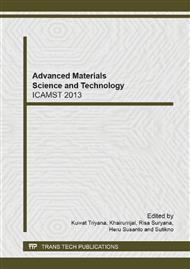p.141
p.145
p.149
p.153
p.159
p.163
p.168
p.175
p.179
Enrichment of Indonesian Low Rank Coal's Surface Oxygen Compounds (SOCs) Using Hydrogen Peroxide and its Adsorptive Properties
Abstract:
Cheap and highly abundant low rank coal from Banten, West Java, Indonesia, was utilized as an adsorbent for a cationic dye. The previous reports show that raw low rank coal has low adsorption capacity when compared to activated carbon. It is also indicated that the coals surface oxygen compounds played a major role in the adsorption mechanism. This research aimed to enrich the oxygen compounds on the coals surface by a straightforward oxidation process using hydrogen peroxide and to investigate the adsorption capacities of raw and treated coals using cationic dye solutions. The oxidation process was conducted by adding the raw coal in hydrogen peroxide solutions having concentrations of 5%, 10%, and 20%, followed by stirring for 10 minutes to 60 minutes. After a serial of washing processes and air-drying, the adsorption capacities of the treated coals for a cationic dye were investigated using batch tests. The batch tests were conducted by adding 0.1 to 0.3 g of coals to 50 mL of methylene blue solutions followed by stirring the solutions for 5 hours. The experimental data were plotted using Langmuir adsorption isotherm model. The adsorption capacity of a treated coal when plotted using Langmuir isotherm was found to be 103 mg/g, significantly higher than that of the raw coal, which was only 52 mg/g. The FTIR spectra showed new absorption of carboxylates at 1700 cm-1 indicating increases in the oxygen containing groups, whilst the surface area measurement indicated an increase in surface area from 0.097 m2/g to 0.232 m2/g. It is concluded that the treatment using hydrogen peroxide solution has significantly improved the surface oxygen compounds of the low rank coal, increased its surface area and also its adsorption capacity for a cationic dye.
Info:
Periodical:
Pages:
159-162
Citation:
Online since:
February 2014
Authors:
Keywords:
Price:
Сopyright:
© 2014 Trans Tech Publications Ltd. All Rights Reserved
Share:
Citation:


